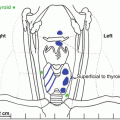Assessment
Serum calcium (> upper limit of normal)
1.0 mg/dL (0.25 mmol/L)
Skeletal
Bone mineral density: T-score ≤2.5 at lumbar spine, total hip, femoral neck, or distal 1/3 radius
Vertebral fracture by imaging
Renal
Creatinine clearance <60 mL/min
24-h urine calcium >400 mg/day (>10 mmol/day) and increased stone risk by biochemical stone risk analysis
Presence of nephrolithiasis or nephrocalcinosis by radiograph, ultrasound, or computed tomography
Age (years)
<50
Regarding calcium and vitamin D intake for patients with asymptomatic PHPT, studies have shown that there is no indication for dietary calcium restriction; 800–1000 mg daily dietary calcium intake is recommended, but less may be considered in patients with hypercalciuria [15]. In addition, vitamin D-deficient patients with PHPT have been shown to have higher levels of PTH, markers of bone turnover, and more frequent fractures than vitamin D-replete patients [14]. Vitamin D repletion in patients with PHPT doesn’t exacerbate hypercalcemia and low serum 25-hydroxyvitamin D should be replaced with vitamin D supplementation aiming to bring the serum 25-hydroxyvitamin D levels to the level of at least 20 ng/mL [8, 16].
In this case, a DXA BMD revealed osteopenia at the total hip and femur neck with T-scores of −1.1 and −1.5, respectively, well-preserved bone density at the lumbar spine with a T-score of −0.1, and a nondominant left one-third radius T-score of −0.9. Spine radiographs did not reveal compressive fractures. Her 10-year risks for a major osteoporotic fracture and hip fracture were 10 % and 1.5 %, respectively. Imaging of her kidneys was negative for urinary calculi. Her 25-hydroxyvitamin D deficiency level was sufficient. A 24-h urine calcium was 135 mg with a fractional excretion of filtered calcium of 0.014, which in conjunction with a negative family history of hypercalcemia made FHH unlikely.
After completion of the initial evaluation, the patient was seen for follow-up to determine management of her mild and uncomplicated PHPT. The natural history of mild PHPT suggests that progression can occur, such that by 15 years of prospective follow-up, as many as one-third of subjects will demonstrate more overt features of the disease (e.g., kidney stones, worsening hypercalcemia, and reduced BMD) [17]. Hence, surgery should be considered in patients for whom medical surveillance is not desired. In addition, compared to observation, successful parathyroid surgery is associated with spine and hip bone density improvement [18], reduced rate of nephrolithiasis among those with a history of renal stone disease [19], and there may be improvement in some neurocognitive elements [20–22]. In these cases, an informed discussion needs to be had and patient’s preference is pivotal for a shared decision-making approach. With advances in the effectiveness and safety of surgical techniques, particularly in the hands of expert parathyroid surgeons [23, 24], the decision to remove the abnormal parathyroid tissue is often reinforced by the added confidence of its success and limited risk of postoperative complications.
Given the patient’s ongoing symptoms of lower extremity pain as well as concern of long-term complications and progression of PHPT, she elected to consider parathyroid surgery and meet with an experienced endocrine surgeon. A parathyroid scan was subsequently performed, but was non-localizing. After her appointment with the surgeon, she elected to observe, rather to proceed with parathyroidectomy. Asymptomatic patients who do not undergo surgery require monitoring for worsening hypercalcemia, renal impairment, and bone loss. The development of any of these findings may indicate disease progression and the reconsideration of surgical intervention. The Fourth International Workshop [13] recommendations for monitoring asymptomatic PHPT are outlined in Table 1.2.
Table 1.2
Guidelines for monitoring observed patients with mild asymptomatic primary hyperparathyroidism
Assessment | |
|---|---|
Serum calcium | Annually |
Skeletal | Bone mineral density every 1−2 years (spine, hip, wrist) |
Imaging of spine if clinically indicated (e.g., height loss, back pain) | |
Renal | eGFR, serum creatinine annually |
If renal stones suspected, 24-h biochemical stone profile, renal imaging by X-ray, ultrasound, or computed tomography |
Outcome
Repeat laboratory investigations and a follow-up visit were scheduled in a year time interval. Given the fact that level of 25-hydroxyvitamin D was 28 ng/mL, it was recommended to continue with dietary intake of vitamin D 800 IU daily and as well maintain a moderate dietary calcium intake of about 1000 mg/day. Finally, the patient was instructed to avoid dehydration and to contact us if any problems related to PHPT occurred in the interim.
Clinical Pearls/Pitfalls
Most PHPT patients in the community are asymptomatic and identified incidentally through a serum calcium measurement.
An evaluation of PHPT-related complications should be performed prior to deciding upon management.
Patients who do not meet surgical criteria or are unable or unwilling to proceed with parathyroidectomy should be monitored on an annual basis, since over time approximately one-third of patients will demonstrate disease progression.
Stay updated, free articles. Join our Telegram channel

Full access? Get Clinical Tree





